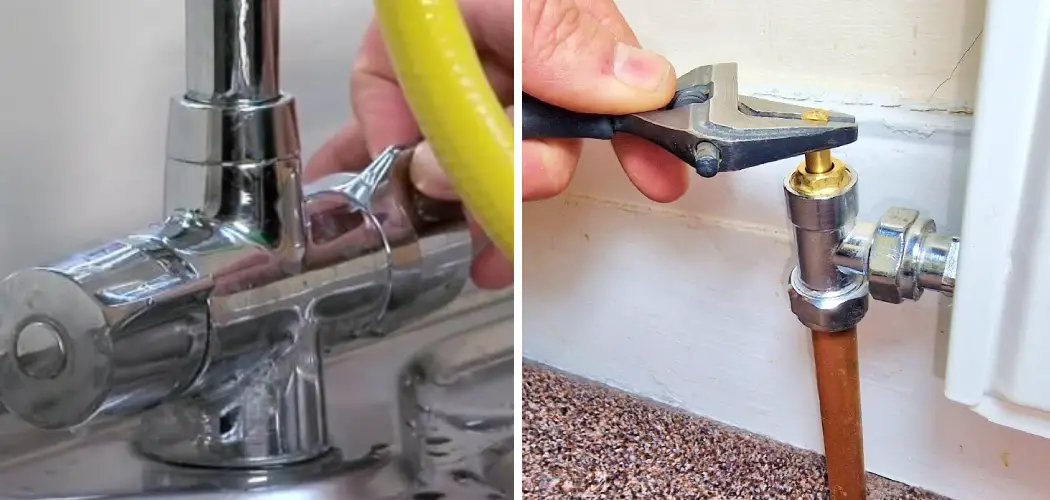Airlocks in water pipes can be annoying and frustrating, especially if you’re experiencing low or no water pressure. This is a common problem that can occur for various reasons, such as installation errors, air trapped during routine maintenance, or simply from using the tap infrequently.
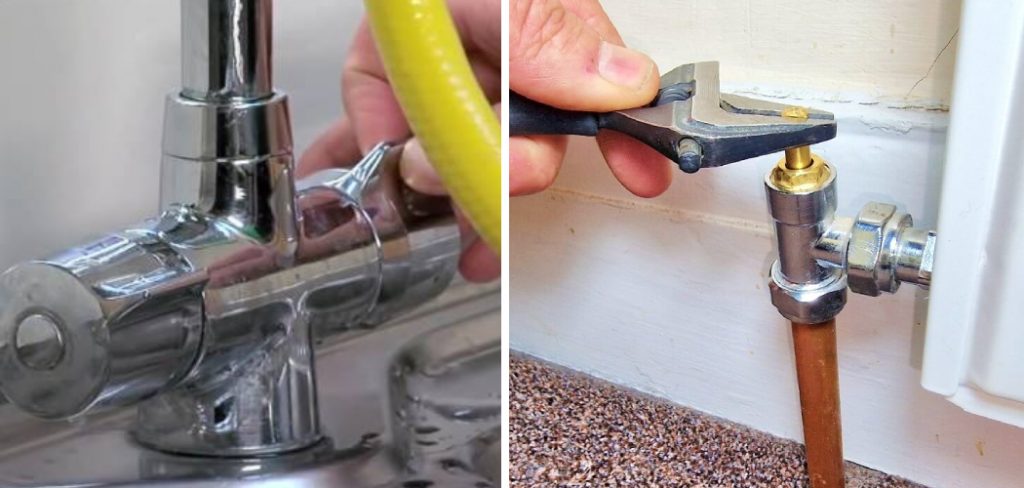
Fortunately, there are simple steps you can take to clear an airlock in your water pipes and restore proper water flow. In this guide, we will discuss the causes of airlocks and provide tips on how to clear airlock in water pipes and prevent it from happening in the future.
What is an Airlock?
An airlock in a water pipe essentially traps air that prevents water from flowing through the pipes. This can happen when there is a break or disconnection in the pipeline, causing air to enter and become trapped.
As a result, you may experience low or no water pressure when trying to use your taps or shower. It’s important to address airlocks as soon as possible, as they can lead to further issues, such as burst pipes or damage to appliances that rely on water flow.
Understanding Airlocks in Water Pipes
To effectively clear airlocks, it’s helpful to understand the common causes that lead to them. Here are a few reasons why airlocks can occur in water pipes:
- Installation Errors – During installation or repairs, air can become trapped in the pipes and get stuck at certain points.
- Inadequate Venting – If your plumbing system does not have proper venting, air can get trapped and cause an airlock.
- Infrequent Use – If you have a tap or shower that is not used regularly, air can enter the pipes and become trapped over time.
- Pipe Damage or Leaks – A break or disconnection in the pipeline can allow air to enter and cause an airlock.
Step-by-step Guidelines on How to Clear Airlock in Water Pipes
Step 1: Identify the Affected Tap or Shower

The first step is to identify which tap or shower is experiencing low or no water pressure. This will help you narrow down the location of the airlock and focus your efforts on clearing it.
If multiple taps or showers are affected, it’s likely that the airlock is in a common section of piping. This could be due to a main water supply issue, so it’s best to contact your local water provider for assistance.
Step 2: Turn Off the Water Supply
Before attempting to clear the airlock, make sure to turn off the water supply to the affected tap or shower. This will prevent any potential leaks or bursts in case of a sudden surge of water when clearing the airlock.
Also, ensure that you turn off any appliances that rely on water flow, such as a washing machine or dishwasher. If you need help with how to turn off the water supply, consult your home’s plumbing manual or contact a professional plumber.
Step 3: Open All Taps
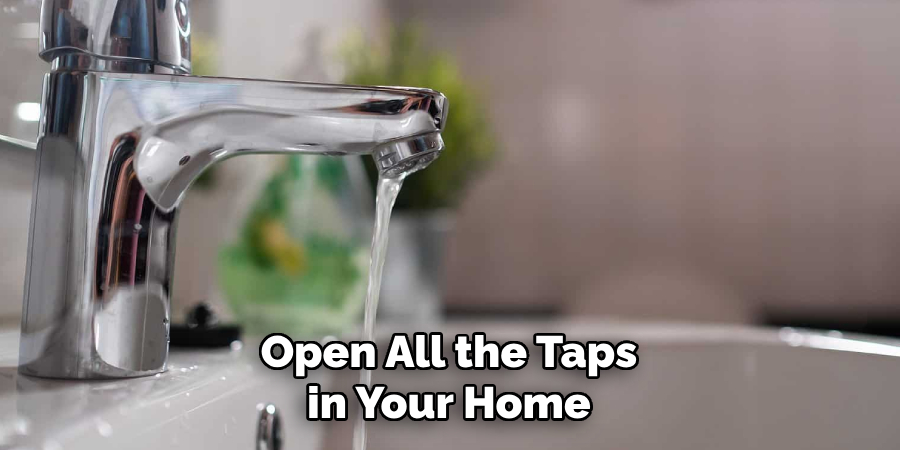
Next, open all the taps in your home. This will help release any excess air from the pipes and assist in clearing the airlock. Keep the taps open until you notice a steady flow of water coming out. This may take a few minutes, so be patient. Also, open any external taps or hoses connected to your plumbing system.
Step 4: Locate the Highest Tap
Once you have opened all the taps, locate the tap that is highest in your home. This could be an upstairs shower or a tap on the top floor. By opening this tap and allowing water to flow through it, it will help push out any remaining trapped air in the pipes. Locating the highest tap is key in effectively clearing airlocks. This step is especially important if your home has multiple floors.
Step 5: Turn Off the Highest Tap
After a few minutes of having the highest tap open, turn it off and check the other taps in your home. If they are all running with steady water flow, you have successfully cleared the airlock. If not, repeat steps 2-4 until the issue is resolved.
This may take a few tries, but eventually, the airlock should clear, and normal water flow will be restored. Also, be sure to check any appliances that rely on water flow, such as a hot water heater or fridge with an ice maker.
Following these steps should help you clear airlocks in your water pipes and restore proper water flow. In addition to these guidelines, it’s important to prevent future airlocks by regularly using all of the taps and showers in your home. If you suspect a larger issue with your plumbing system, it’s best to contact a professional plumber for assistance.
Additional Tips and Tricks to Clear Airlock in Water Pipes
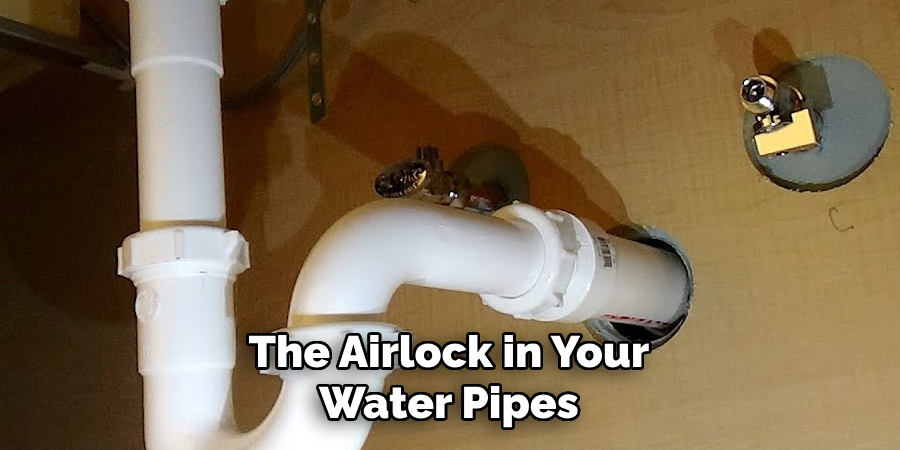
- If the initial methods fail to clear the airlock in your water pipes, try using a plunger. Place the plunger over the affected faucet and plunge up and down for several seconds. This can help push any trapped air through the pipes.
- You can also try turning on multiple faucets at once to increase water pressure and force out any trapped air. Be sure to turn them off once the water starts flowing smoothly. If this doesn’t work, try turning on the main water valve to the highest setting and then gradually reduce it. This can help dislodge any air bubbles in the pipes.
- If your home has a hot water recirculating system, you can also try manually cycling the pump to force out any trapped air. Consult your system’s manual for instructions on how to do this.
- In extreme cases where the airlock is deep in the pipes and cannot be cleared by conventional methods, you may need to call a professional plumber. They have specialized tools and techniques that can effectively remove airlocks from water pipes.
- To prevent future airlocks, try regularly flushing your pipes by turning on all faucets in the house for a few minutes. This can help push out any trapped air and sediment, keeping your pipes clear and preventing future blockages.
- Another preventive measure is to install an air release valve or automatic air vent at high points in your plumbing system. These valves automatically release any trapped air before it can cause an airlock.
- If you live in an area with extremely cold temperatures, make sure to insulate your pipes to prevent freezing and potential airlocks. Also, be sure to drip faucets during freezing weather to keep water flowing and prevent air from getting trapped.
- Regularly check the water pressure in your home. Low water pressure can indicate a potential airlock or other plumbing issues that should be addressed.
- Lastly, it’s always a good idea to understand your home’s plumbing system and know where the main water valve is located in case of emergencies. This can save you time and money when dealing with airlocks or other issues in the future.
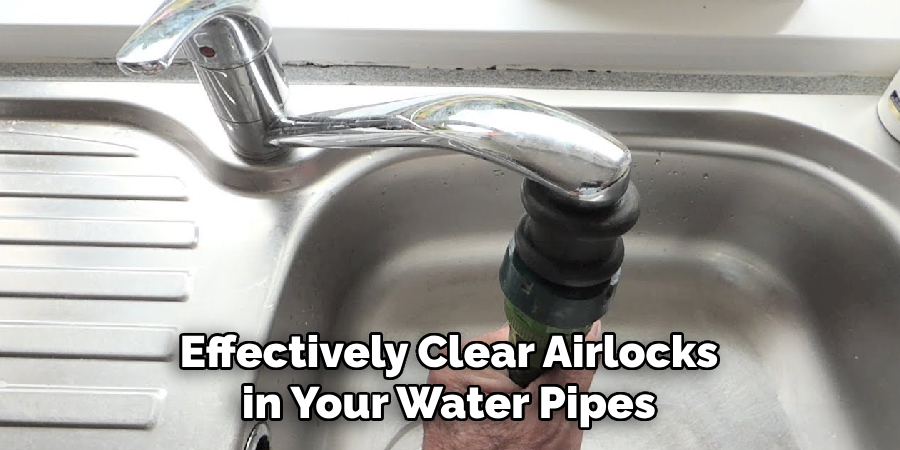
These tips and tricks can help you effectively clear airlocks in your water pipes and prevent them from reoccurring. Always be cautious when dealing with your plumbing system, and don’t hesitate to call a professional if needed. Keep your water flowing smoothly by regularly maintaining your pipes and staying informed about potential issues. Happy plumbing!
Things You Should Consider to Clear Airlock in Water Pipes
- The first thing you should consider is the state of your water pipes. If they are old and rusty, chances are that there will be an airlock in them. This can happen when a section of the pipe is damaged or corroded and creates a pocket of air.
- Another thing to consider is the type of water you are using. Different types of water have varying levels of dissolved gas. If you use hard water, which has a high mineral content, there is a higher chance of an airlock forming in your pipes.
- Regular maintenance is key to preventing airlocks in water pipes. Over time, debris and sediment can build up in the pipes, causing blockages that trap air pockets. It’s important to have your plumbing system inspected and cleaned regularly to avoid this issue.
- If you are experiencing an airlock in your water pipes, one solution is to try bleeding the air out of the system. This involves turning off the main water supply and opening all faucets in your home until the pipes are drained completely. Then, turn on the main supply again and slowly open each faucet one at a time until all air is released from the pipes.
- Installing a water softener can also help prevent airlocks in your water pipes. Soft water has lower levels of dissolved gas, making it less likely for air pockets to form in the pipes.
- Another method to clear an airlock in water pipes is by using a plunger on the affected faucet. This works by creating pressure and forcing the air out of the pipes. However, there may be more effective methods for larger air pockets.
- In extreme cases where the above methods do not work, it may be necessary to call a professional plumber. They have specialized tools and techniques to remove stubborn airlocks in water pipes.
- It’s important to address an airlock in water pipes as soon as possible, as it can lead to reduced water pressure and even burst pipes if left untreated. Keeping an eye out for the signs of an airlock, such as sputtering faucets or strange noises from your pipes, can help you catch the issue early on.
- Prevention is always better than a cure when it comes to airlocks in water pipes. Regular maintenance, using the right type of water, and installing a water softener can go a long way in preventing this issue.
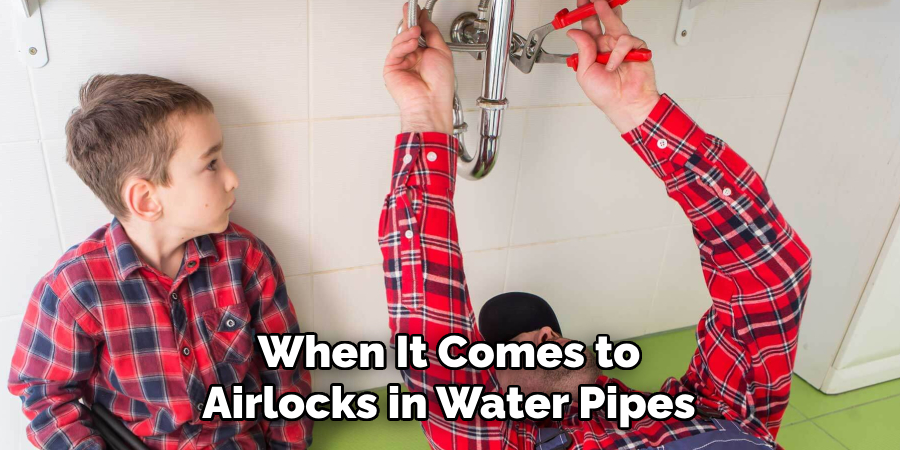
Following these considerations can help keep your water pipes clear and functioning properly, providing you with a reliable supply of clean water. So, next time you notice any issues with your water pressure or hear strange noises from your pipes, don’t ignore them and take the necessary steps to clear any potential airlocks in your water system.
Remember, taking care of minor issues now can save you from costly repairs and inconveniences in the future. Keep your water pipes in top condition to ensure a smooth-running household. So, be proactive and take care of your plumbing system to avoid any potential problems down the line. Proper maintenance and timely action allow you to keep your water pipes clear and free from airlocks. Happy plumbing!
Precautions Need to Be Followed for Clearing Airlock in Water Pipes
- First and foremost, it is important to understand the airlock in water pipes clearly. The airlock is an accumulation of trapped air that can occur within your water pipes, disrupting the flow of water.
- Before attempting to clear the airlock, make sure to turn off the main water supply to avoid any potential accidents or injuries.
- To clear the airlock, you will need to locate the affected pipe or faucet. This can be done by turning on each faucet in your home and identifying which one has no water flow.
- Once you have identified the affected area, it is necessary to release the trapped air by opening up the tap fully. This will allow the air to escape and restore proper water flow.
- It is important to note that water may initially come out sputtering or spluttering due to the air being released. This is normal and should not last for more than a few seconds.
- If the above method does not work, try using a plunger on the affected faucet to help push the trapped air out.
- In some cases, attaching a hose to the affected faucet and running water through it for a few minutes may be necessary. This can help dislodge any stubborn air pockets.
- It is essential to monitor the water flow after clearing the airlock to ensure that it has been successfully cleared. If there are still issues, it may be best to seek professional help.
- Regularly checking and maintaining your water pipes is also recommended to prevent future airlocks. This can include periodic flushing of the pipes or installing air-release valves.
Following these precautions can help prevent any accidents or further issues when clearing an airlock in water pipes. It is always better to be cautious and take the necessary steps to properly clean the airlock rather than risk potential damage or injury. Understanding how airlocks occur and knowing the proper methods for clearing them can ensure a smooth and safe process for restoring water flow in your home.
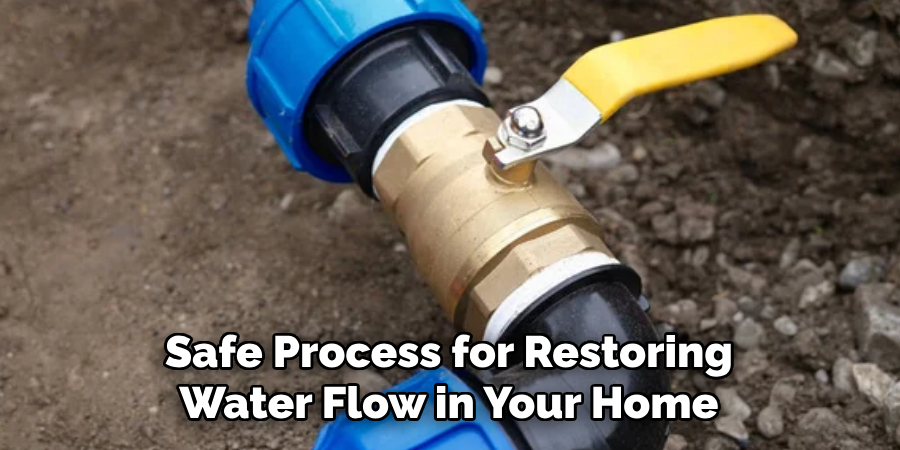
Frequently Asked Questions
What Causes Airlocks in Water Pipes?
Airlocks in water pipes are caused by a pocket of air that becomes trapped within the pipe. This can happen when the water supply is turned off temporarily or when there is a leak in the system, allowing air to enter. When this happens, it can create an obstruction in the flow of water, causing reduced pressure and sometimes even complete blockage.
What Are Some Common Signs of an Airlock?
Some common signs of an airlock include reduced or no water flow, strange noises coming from the pipes, and inconsistent water pressure. You may also notice that your taps are sputtering or spitting out air instead of a steady stream of water.
How Do I Know If I Have an Airlock in My Water Pipes?
If you suspect that you have an airlock in your water pipes, the best way to confirm is by checking multiple faucets in your home. If all of them are experiencing reduced pressure or no water flow, it is likely that there is an airlock in your system.
How Can I Prevent Airlocks from Occurring?
One way to prevent airlocks from occurring is by ensuring that your water supply is turned off properly and securely after any maintenance or repairs are done. It’s also important to regularly check for leaks in your pipes and have them fixed promptly to prevent air from entering the system.
How Do I Clear an Airlock in My Water Pipes?
To clear an airlock in your water pipes, you will need to locate the highest point of the system, which is usually the highest faucet in your home. Start by turning off the water supply and then turn on this faucet. As it runs, slowly turn on all of the other faucets in your home until the water starts flowing consistently again. This will help release any trapped air within the pipes.
Are There Any Other Methods for Clearing Airlocks?
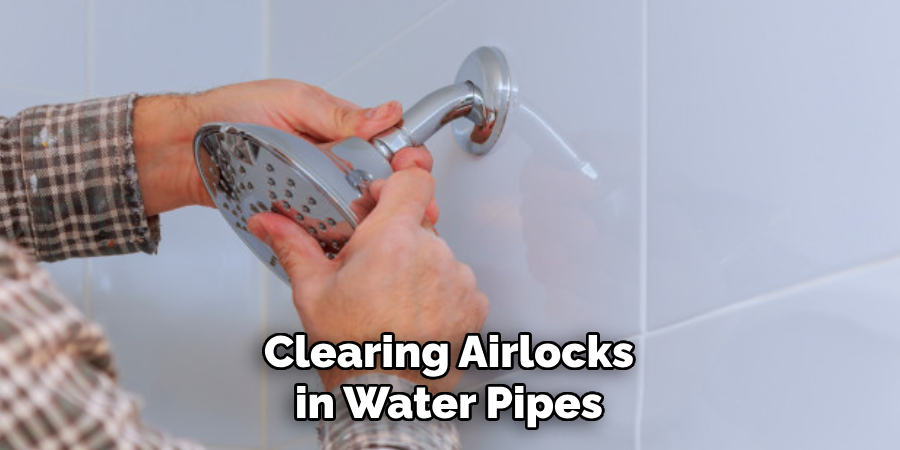
Yes, there are other methods for clearing airlocks in water pipes. Some people recommend using a plunger to create pressure and force the air blockage out of the pipe. Others suggest filling a cloth bag with ice cubes and placing it over the highest faucet to help push the air out as it melts.
Conclusion
Now you know how to clear airlock in water pipes and prevent them from occurring in the future. By following these simple steps, you can ensure that your water supply remains consistent and uninterrupted.
If you continue to experience issues with airlocks, it may be a sign of a larger problem, and it’s best to consult a professional plumber for assistance. Regular maintenance and prompt repairs are key to keeping your water pipes running smoothly. So, stay vigilant and take care of your water system to avoid any future disruptions. Happy plumbing!

